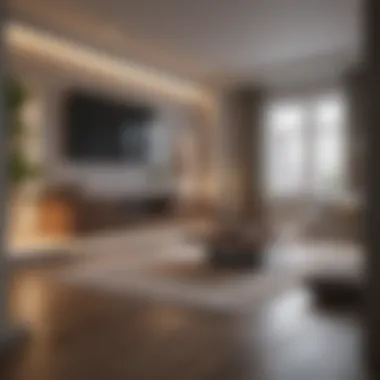Studio vs One Bedroom Apartments: Key Insights


Intro
When navigating the delicate balance between space, functionality, and cost, the choice between a studio apartment and a one-bedroom apartment stands as a significant decision for many potential renters and buyers. Each option presents unique advantages and drawbacks, directly affecting the lifestyles of their inhabitants. This analysis aims to provide a comprehensive guide that meticulously evaluates these two housing styles, helping discerning readers understand their implications in a modern living context.
Understanding these living arrangements goes beyond mere square footage. A studio apartment typically involves a single open space that combines living, sleeping, and kitchen areas, while a one-bedroom apartment features a distinct bedroom separated by walls. But how do these differences translate into daily life? Cost, design choices, and lifestyle compatibility all play crucial roles in this comparison.
In this discussion, various aspects will be addressed. From architectural features and interior design inspirations to functionality in daily use, each section will delve into the factors that are relevant when choosing between the two options. By identifying market trends and cultural factors impacting decisions, potential residents can gain insightful perspectives into what each type of apartment has to offer.
Let's begin by examining the Home Features, which highlight the architectural and unique design elements of studio and one-bedroom apartments.
Preamble to Apartment Types
Understanding the differences between studio and one-bedroom apartments is critical for anyone considering a move. Each type offers unique benefits and challenges that can significantly impact daily living and financial status. This section serves as a foundational overview of these two housing options, highlighting pertinent factors to aid potential renters or buyers in their decision-making process.
Selecting the right apartment type involves considering both personal preferences and lifestyle needs. For instance, studio apartments are often more affordable and can promote a minimalist lifestyle. On the other hand, one-bedroom apartments allow for more privacy, which may appeal to couples or individuals desiring separate living spaces.
Ultimately, this comparison aims to clarify the choices available in apartment living, contextualizing the broader implications of each type within the housing market and personal finance.
Defining Studio Apartments
A studio apartment is typically a compact living space that combines the bedroom, living room, and kitchen into a single area. The layout is characterized by an open floor plan, which can sometimes include a bathroom. This design optimizes the available space and often results in lower rental costs. In urban settings, studios are popular among young professionals or students who value location and affordability over square footage.
Studios often feature limited storage options, requiring residents to be more intentional about their belongings. However, innovative furniture solutions, such as foldable beds and multifunctional items, can enhance livability in these smaller spaces.
Defining One Bedroom Apartments
One-bedroom apartments offer a distinct advantage by separating the sleeping area from the living spaces. This layout typically includes a separate bedroom, a living room, a kitchen, and often a bathroom. The additional room provides a level of privacy and allows for more substantial interior design options. One-bedroom apartments are favored by couples and individuals who may work from home and need a designated office space.
While one-bedroom units generally come with higher costs compared to studios, they tend to have better storage solutions and often include amenities that studios might lack. Additionally, the layout can create a sense of home that is conducive to a more settled lifestyle.
Both studio and one-bedroom apartments cater to specific market demands and personal needs. Evaluating these can help guide individuals towards their ideal living situation.
Space Utilization and Layout
Understanding space utilization and layout is essential when comparing studio and one-bedroom apartments. This aspect greatly influences your overall living experience, affecting functionality, style, and comfort. In a studio apartment, maximizing the smaller space can lead to innovative design ideas and creative solutions for everyday living. Conversely, one-bedroom apartments offer more distinct areas, allowing for both separation and personalization in living, cooking, and sleeping spaces.
In this section, the focus will be on how effective layout can enhance the livability of each apartment type. The choice between these two formats can depend on personal preferences and lifestyle needs.
Open Floor Plans in Studios
Studio apartments are characterized by an open floor plan that merges living, cooking, and sleeping areas into a single space. This design approach allows for more flexible arrangements of furniture.
Benefits of Open Floor Plans:
- Maximized Space: In small square footage, openness can create an illusion of more space.
- Natural Light: Fewer walls enable better light flow, vital in enhancing the atmosphere of a studio.
- Versatility in Design: The open layout offers freedom in choosing how to furnish and decorate.
However, an open floor plan comes with challenges. Lack of privacy can be a concern, especially for those sharing the space. Additionally, organizational skills become critical. Without defined areas, clutter can disrupt cohesion and aesthetics.
Defined Spaces in One Bedrooms
One-bedroom apartments provide a distinctly separate layout, with a separate room designated for sleeping. This layout can offer a sense of stability, as each space serves its exclusive function.
Advantage of Defined Spaces:


- Privacy: A bedroom provides a personal sanctuary, not interrupted by other activities.
- Organization: Having separate areas can aid in zoning, making it easier to manage belongings and tasks.
- Room for Design: Each area can reflect different design concepts or themes, allowing for more complexity in decor.
Nonetheless, these benefits come with increased responsibilities regarding maintenance and cleaning. Separate spaces require more effort to keep organized and tidy.
"Choosing between a studio and a one-bedroom apartment often depends on personal preferences regarding layout and space utilization."
Ultimately, both layouts carry their distinct advantages and considerations. The open space of a studio can be appealing for those who value creativity and flexibility, while the separate areas of a one-bedroom offer a structured environment conducive to privacy and organization.
Cost Analysis
Cost analysis is a critical aspect when evaluating studio and one-bedroom apartments. It provides potential renters and buyers with a clear understanding of the financial commitments associated with each type of living space. The decision on which apartment to choose often hinges on several factors, such as overall affordability, value for money, and the specific financial implications of renting versus purchasing.
Understanding both short-term and long-term costs can guide individuals in making informed choices that suit their financial situations and future goals. This section will detail essential elements like rent and ownership costs, as well as utilities and maintenance expenses that influence budget considerations.
Rent and Ownership Costs
When it comes to rent and ownership costs, one-bedroom apartments tend to be more expensive than studio apartments. The rental price can vary significantly based on location, size, and amenities. On average, studios offer a lower price point, making them more approachable for young professionals or students who may be on a tight budget.
Key Points to Consider:
- Average Rent: Studios often come at a lower rental rate, which may help individuals save money each month.
- Ownership: For those looking to buy, one-bedroom units are generally considered a better investment due to their potential for appreciation and resale value.
- Down Payment: A larger down payment is typical for one-bedroom apartments, which may challenge first-time buyers financially.
- Long-Term Value: One-bedroom apartments may generate better long-term financial returns, especially in urban areas where space is limited.
Utilities and Maintenance Expenses
Utilities and maintenance are another crucial part of the cost analysis. Typically, residents in studio apartments can expect lower utility bills due to the smaller square footage. In contrast, one-bedroom apartments, while potentially offering more space, can also incur higher utility costs.
Important Considerations:
- Utility Bills: Studios usually require less electricity and heating, making them more cost-effective in terms of monthly expenses.
- Maintenance Fees: If considering ownership, one-bedroom properties may come with higher ongoing maintenance costs compared to studios, especially in buildings with more amenities.
- Insurance Costs: Renters insurance for studios is generally less expensive. However, owning a one-bedroom may require a more comprehensive policy.
In sum, analyzing costs is essential when selecting between studio and one-bedroom apartments. Understanding the detailed implications of rent and utility expenses helps individuals and families align their choice with their financial capabilities and lifestyle preferences.
As the housing market evolves, individuals need to stay informed about potential fluctuations in costs to make sound investment decisions
For further details, you might consider exploring Britannica for market trends and insights regarding housing investments.
Design Considerations
Design considerations play a pivotal role in selecting a living space, especially when comparing studio and one-bedroom apartments. The design not only affects the aesthetic appeal but also influences how residents utilize their spaces for daily activities. A well-thought-out design can maximize functionality and comfort, catering to the unique needs of the inhabitants.
Key elements in design considerations include layout, lighting, and storage solutions. Each aspect directly impacts the living experience. For instance, studios often require multifunctional furniture to accommodate limited space effectively, whereas one-bedroom apartments may have more flexibility in design choices due to their additional square footage. Understanding the nuances of these elements assists potential renters and homeowners in making choices that enhance their lifestyles.
Decorating Studio Spaces
Decorating studio spaces demands creativity and an eye for innovative solutions. In these compact environments, every piece of furniture should serve a purpose without overwhelming the room. Here are some essential tips for effective decoration:
- Use Multifunctional Furniture: Opt for sofa beds or foldable tables to maximize utility.
- Vertical Space Utilization: Hanging shelves or tall bookcases can add storage without consuming floor space.
- Color Schemes: Lighter colors can create an illusion of a bigger space, whereas darker hues can make it feel cozier.
Lighting is also crucial in studio spaces. Natural light should be harnessed as much as possible, while strategically placed artificial lights can enhance the ambiance at night.
Interior Design for One Bedrooms
In contrast, one-bedroom apartments offer more room for creative expression in design. The additional space allows for more distinct zones for living, working, and sleeping.
Considerations include:


- Separate Areas: Use rugs or furniture placement to define distinct areas like a living room separate from the bedroom.
- Personalization: With more room, residents can comfortably incorporate personal style through art, decorative pieces, and thoughtful layouts.
- Storage Solutions: Built-in closets and cabinets become more essential, as they can help maintain a clean look while providing ample space for belongings.
"The choice between a studio and a one-bedroom should be a reflection of one's lifestyle and personal taste. Each design can cater to different needs."
The design aspects of either apartment type significantly influence livability. Designers often emphasize that thoughtful decoration can transform even the simplest space into a comfortable and inviting home.
Lifestyle and Functionality
The lifestyle and functionality of living spaces is critical in determining the right choice for potential renters and buyers. Each type of apartment serves different needs, impacting daily life in various ways. Understanding how these apartments cater to the requirements of individuals and couples alike can significantly influence one’s decision. Evaluating aspects such as comfort, convenience, and adaptability is essential before making a commitment.
Suitability for Singles and Couples
When considering studio apartments, they are often seen as ideal for singles or young couples. With their open layouts, studio apartments provide a compact yet efficient space that encourages functionality. The lack of walls allows for versatile living arrangements. Individuals who prioritize affordability and low maintenance often find studio apartments appealing.
On the other hand, one-bedroom apartments tend to accommodate both singles and couples effectively, but with distinct advantages. The separation of living and sleeping areas can enhance privacy, which many couples value. Additionally, one-bedroom units can often better host guests, making them suitable for entertaining. Couples who desire a bit more space may lean towards one-bedroom apartments, as they provide a designated area for various activities without compromising on intimacy.
Impact on Storage and Organization
Storage solutions vary greatly between studio and one-bedroom apartments. In a studio, the integrated design can limit storage options. Residents often need to be more creative. Utilizing multifunctional furniture, like ottomans with storage or wall-mounted shelves, becomes necessary. Efficient organization helps maximize the use of space.
Conversely, a one-bedroom apartment generally offers more storage opportunities. They often have dedicated closets and extra nooks for storage, which are invaluable for residents who have more belongings. This is particularly relevant for couples or individuals with hobbies that require equipment or supplies. Having distinct spaces for different uses can lead to a more organized and efficient living environment.
In summary, whether one chooses a studio or a one-bedroom apartment largely depends on their lifestyle needs. Singles and couples should assess what they prioritize in their living arrangements and how these choices affect organization and functionality in their day-to-day lives.
"Living space choices can define one's comfort and ease in daily routines. Consider all aspects before making a decision."
Choosing wisely is imperative. Each option presents unique merits that should align with personal lifestyles and preferences.
Market Trends
Understanding the market trends for studio and one-bedroom apartments is crucial for potential renters and buyers. This section provides insights into current preferences and shifts in the housing market, reflecting broader lifestyle changes and economic conditions.
Current Demand for Studio Apartments
Studio apartments have seen a consistent demand pattern, particularly in urban areas. These units appeal significantly to young professionals and students who prioritize affordability and location over space. The compact design allows for easier maintenance and lower utility costs.
Key factors driving demand for studio apartments include:
- Affordability: Many individuals face budget constraints, making studios a popular option.
- Location: Proximity to workplaces and entertainment hubs increases appeal, especially for those who own fewer furnishings.
- Simplicity and Minimalism: A growing trend towards minimalism encourages people to declutter their lives, making studios a logical choice.
Demographic changes also play a critical role in this demand. Cities witnessing an inflow of young adults often report increased interest in studio living arrangements.
Shifts Towards One Bedroom Units
Recently, there has been a notable shift towards one-bedroom apartments, especially among couples and growing families. This trend reflects changing lifestyle needs, where individuals prefer more defined living spaces as their circumstances evolve.
Factors influencing this shift include:
- Increased Remote Work: The rise of remote work encourages individuals to seek more spacious environments.
- Life Stages: As renters progress in career and personal life, they may require additional space for work or family.
- Investment Potential: One-bedroom apartments tend to offer better long-term investment opportunities compared to studios due to higher resale values.
"While studio apartments continue to be in demand, the trend towards one-bedroom units signals a shift in buyer priorities, focusing on space and lifestyle needs."
This increasing interest in one-bedroom units suggests a dynamic housing market that adapts to the needs of its residents. By examining these trends, potential renters and buyers can make informed decisions aligned with their current and future needs.
Cultural Influences on Apartment Choice


Cultural factors play a crucial role in influencing preferences for housing types, including studio and one-bedroom apartments. These influences encompass a variety of elements such as geographic location, lifestyle choices, and societal norms. Understanding these factors is vital for renters and buyers as they navigate the complex landscape of apartment selection.
Exploring how culture shapes our living arrangements allows individuals to make decisions that more closely align with their values and lifestyles. Cultural influences can create trends that impact not just personal choices, but also market demand and the development of property types.
Urban vs. Suburban Preferences
Urban and suburban living each have distinct cultural vibes that can ultimately sway apartment choice. In urban areas, there is often a preference for studio apartments. The compact nature of these units aligns with the fast-paced lifestyle many urban dwellers lead. Living in a downtown area may provide proximity to work, social activities, and public transportation. Thus, a studio apartment might be seen as a desirable option.
Conversely, suburban environments typically attract families or individuals seeking more space. In these locales, one-bedroom apartments—often part of larger complexes or townhouses—are more common. They typically provide a designated sleeping area separate from living spaces, which can be more suitable for those who prioritize privacy and have evolving needs, such as accommodating guests.
Some factors influencing this preference include:
- Lifestyle Considerations: More active urban environments often favor studios, whereas quiet suburbs may draw interest in one-bedroom options.
- Commuting Needs: City dwellers may prefer shorter commutes, making studios more practical, while those in suburban areas might opt for larger units to balance home and family life.
Generational Trends in Housing Selection
Different generations exhibit varied preferences when it comes to housing. For example, millennials and Gen Z are often drawn to studio apartments due to their affordability and ease of maintenance. These generations are typically in transitional life stages, perhaps prioritizing flexibility in living arrangements.
Meanwhile, older generations, like baby boomers, may lean towards one-bedroom apartments, opting for downsizing options that provide a comfortable living environment without excessive space. The desire for community amenities and accessible services also influences these age groups, contributing to the ever-shifting landscape of apartment choice.
Factors to consider include:
- Technology Integration: Younger generations appreciate smart home features that are generally more available in urban studio settings.
- Financial Goals: The investment outlook may alter choices, where younger individuals keen on saving might select studios, while older individuals consider the potential for equity gain in one-bedroom units.
Understanding these generational trends can help potential buyers and renters identify the best apartment option for their lifestyle and financial goals.
Potential Investment Value
Understanding the potential investment value of studio and one-bedroom apartments is critical for buyers and investors alike. This aspect not only influences financial decisions but also frames future expectations regarding property appreciation and rental income. Both types of apartments offer unique benefits and drawbacks that can impact their market performance.
Equity in One Bedroom Apartments
One-bedroom apartments generally present a more favorable opportunity for building equity compared to studio apartments. The dedicated living space contributes to a higher perceived value in the eyes of potential buyers. With their distinct layout, these apartments often attract a wider range of tenants, including small families or couples looking for more space. This broader appeal can result in higher demand in competitive markets, facilitating potential appreciation in property value over time.
Moreover, owning a one-bedroom unit can enhance equity growth through mortgage payments. As a mortgage principal is paid down, owners gradually increase their stake in the property. Even in fluctuating markets, one-bedroom apartments tend to retain their value better than studios, minimizing the risk of loss. Investors should also consider the tax advantages associated with owning real estate, such as deductions on mortgage interest and property taxes, further enhancing the appeal of one-bedroom apartments.
Resale Value Trends for Studios
In contrast, studios can offer modest returns on investment depending on location and demand. Their appeal is primarily centered around affordability, making them attractive to first-time buyers or investors targeting the rental market. The lower initial purchase price for studios can be appealing; however, this often comes with limitations.
Research suggests that studios are prone to slower resale appreciation relative to one-bedroom units. In some urban areas, as preferences shift towards larger living spaces and multi-functionality, studios may experience stagnation in value growth. Although rental demand for studios in bustling cities remains relatively high, the overall investment still carries potential risks which investors must weigh carefully.
"While studios can yield satisfying rental returns, their long-term investment potential should align with individual priorities and market conditions."
In summary, both studio and one-bedroom apartments come with unique investment characteristics that potential buyers must consider. Analyzing equity potential, anticipated resale values, and market trends can provide insightful perspectives on which type of apartment may best suit an investor's goals.
Finale
Understanding the distinctions between studio and one-bedroom apartments is essential for anyone considering their living options. Every aspect from the space layout to the cost implications, affects renters' or buyers’ decisions profoundly. This article has covered important elements, which can be categorized into design flexibility, cost efficiency, lifestyle adaptability, and investment potential. Each of these components plays a critical role when evaluating the ideal living arrangement.
The key benefits of studio apartments generally include lower rental prices and simplified living spaces, which can attract those prioritizing affordability and minimalism. In contrast, one-bedroom apartments offer greater privacy and separation of living and sleeping areas, making them more suitable for individuals who may have diverse needs, such as the requirement for a home office.
Furthermore, for potential investors, understanding the resale value trends and market demand will guide strategic decisions about property acquisition. Recognizing generational preferences can also influence choices, as younger generations tend to seek flexibility and affordability, while older demographics might prioritize space and stability.
Ultimately, evaluating both apartment types in line with individual needs and local market conditions lays the groundwork for informed housing decisions.
Final Considerations for Renters and Buyers
As you navigate the decision-making process, keep the following considerations in mind:
- Lifestyle Needs: Your personal habits and lifestyle preferences should dictate your choice. If you are someone who enjoys hosting or simply values having more space, a one-bedroom might be more suitable.
- Budget Constraints: Assess your financial situation carefully. Studio apartments tend to be less expensive, which can be crucial in high-rent areas.
- Future Plans: Consider your long-term plans. If you anticipate needing more space soon, investing in a one-bedroom may be wiser.
- Location Dynamics: Study the location and its offerings. Sometimes, the community surrounding a studio or one-bedroom can significantly impact your living experience.
- Market Trends: Keep an eye on local real estate trends, as they may inform you about better investment opportunities or upcoming developments.



